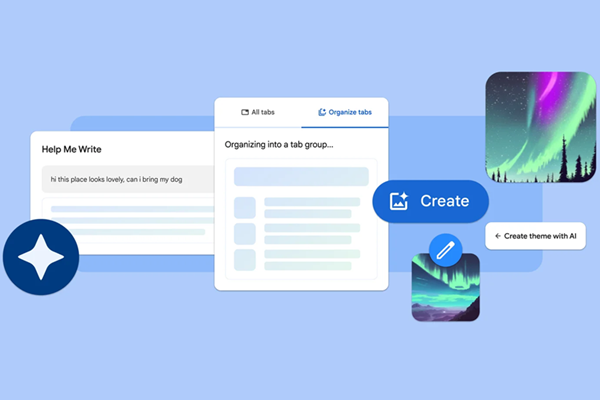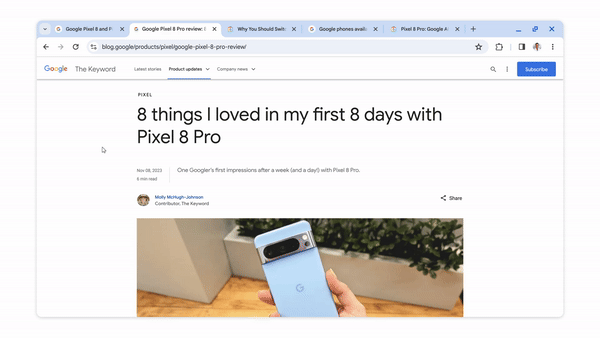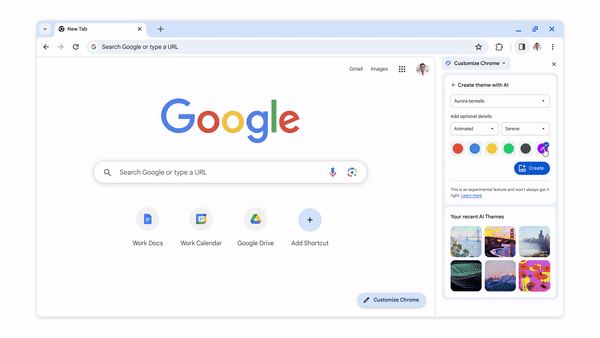Google Chrome Embeds Generative AI to Write Text, Organize Tabs, and Design Browser Experience
 Google Chrome is rolling out three new generative AI features to enhance the web browser as part of a new experimental AI project. The new tools offer Chrome users AI assistance in composing text inside the browser, organizing their tabs, and creating a visual theme for the browser.
Google Chrome is rolling out three new generative AI features to enhance the web browser as part of a new experimental AI project. The new tools offer Chrome users AI assistance in composing text inside the browser, organizing their tabs, and creating a visual theme for the browser.
Generative Google Chrome AI

The Tab Organizer, seen above, employs generative AI to automatically group open browser tabs into categories based on their similarities. Multiple e-commerce tabs might be filed under ‘Summer Clothes Search’ while another group might be ‘Road Trip Itinerary Ideas.’ The idea is to bring order to managing many tabs for different tasks. Users can also have Chrome suggest names and emojis for the generated tab groups.
Chrome will also help compose text with generative AI to fill in a website’s text boxes. Users can right-click the box to brainstorm ideas proposed by the AI on what to write. For instance, it might suggest the text for a social media post or how best to describe a product in a review.
 Chrome’s new theme creator operates like a synthetic image generator but for a whole browser. Users can type up a topic, how they’re feeling, or a style and color palette they like. Chrome’s text-to-image diffusion model will then build an original theme tailored to the prompt and make it the look for the browser, as seen on the left, with the Aurora Borealis as a prompt. The features are all available in Chrome on Macs and PCs, though just in the U.S. for now. You can activate them when they are available from the “Experimental AI” page in Chrome’s settings.
Chrome’s new theme creator operates like a synthetic image generator but for a whole browser. Users can type up a topic, how they’re feeling, or a style and color palette they like. Chrome’s text-to-image diffusion model will then build an original theme tailored to the prompt and make it the look for the browser, as seen on the left, with the Aurora Borealis as a prompt. The features are all available in Chrome on Macs and PCs, though just in the U.S. for now. You can activate them when they are available from the “Experimental AI” page in Chrome’s settings.
“Over the last few years, we’ve brought the latest machine learning and AI technologies into Chrome to make searching the web easier, safer and more accessible. We started with improving practical, everyday tasks, like helping you add real-time captions to videos, better detect malicious sites, manage permission prompts and generate the key points of a webpage,” Chrome vice president Parisa Tabriz explained in a blog post. “Starting with today’s release of Chrome (M121), we’re introducing experimental generative AI features to make it even easier and more efficient to browse — all while keeping your experience personalized to you.”
Google’s Generative AI Infusion
The Chrome features are presumably relying on Google’s Gemini family of LLMs, but it really is just extending Google’s project embedding LLM-powered tools across its products, whether labeled as Gemini, Bard Extensions, or anything else. Chrome is also joining the growing number of web browsers with generative AI features. Opera introduced the Aria generative AI assistant last year, enhancing it with additional generative AI features since the launch, even teaching it to mimic a user’s writing style based on submitted examples. Meanwhile, privacy-focused browser developer Brave incorporated a generative AI assistant named Leo into its platform in November. Mozilla created a proprietary LLM and chatbot for e-commerce but hasn’t made it part of Firefox as of yet.
Follow @voicebotai Follow @erichschwartz
Opera Teaches Generative AI Assistant Aria to Mimic Your Writing Style
Google Releases Gemini Generative AI Model Designed to Match and Exceed OpenAI’s GPT-4 and ChatGPT








